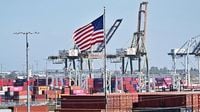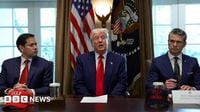The U.S. economy shrank by 0.3% in the first quarter of 2025, marking the first contraction since early 2022, according to the Bureau of Economic Analysis. This downturn has raised concerns of a potential recession, as economists debate the implications of President Trump’s aggressive trade policies and tariffs.
The contraction in gross domestic product (GDP) comes after a period of relative stability, where the economy had expanded by 2.4% in the last quarter of 2024. The latest figures indicate that the economy is on the brink of what is informally defined as a technical recession, which is characterized by two consecutive quarters of negative growth. While the National Bureau of Economic Research defines a recession more formally as a significant decline in economic activity lasting more than a few months, the current data has led many to speculate about the potential for a downturn.
One of the most striking elements of the latest report is a significant drop in consumer sentiment, which plummeted by 32% in April 2025. This marks the lowest level of consumer confidence since the 1990 recession. The decline in sentiment reflects growing unease among consumers and businesses alike regarding the economic outlook, exacerbated by uncertainty surrounding tariffs.
During the first three months of the year, imports surged at an annualized rate of 50.9%, as businesses rushed to stockpile goods ahead of the new tariffs imposed by the Trump administration. This frontloading of imports contributed to a widening trade deficit, which increased by $14 billion to a record $162 billion in March 2025. The expanding trade gap is estimated to have reduced first-quarter GDP growth by approximately five percentage points.
Despite the negative GDP reading, some economists argue that the core economy performed well, with strong consumer and business spending in the first quarter. However, they caution that the anticipated slowdown could be significant later in the year, as tariffs drive up prices and restrain consumer spending.
President Trump, who has returned to the White House, quickly responded to the GDP figures, asserting that the contraction had nothing to do with his tariff policies. In a social media post, he stated, "This is Biden’s Stock Market, not Trump’s. I didn’t take over until January 20th. Tariffs will soon start kicking in, and companies are starting to move into the USA in record numbers. Our Country will boom, but we have to get rid of the Biden 'Overhang.' This will take a while, has NOTHING TO DO WITH TARIFFS, only that he left us with bad numbers, but when the boom begins, it will be like no other. BE PATIENT!!!"
Trump’s remarks come amid a broader media blitz as he marks his first 100 days in office. On the same day as the GDP report, he was scheduled to host CEOs from major companies, including Nvidia and GE Aerospace, and hold a Cabinet meeting with his leadership team.
Investors reacted to the GDP report with concern, as Wall Street stocks opened sharply lower. The S&P 500 index fell by 1.4%, while futures tied to the Dow Jones Industrial Average indicated a 380-point drop, or 0.9%. The Nasdaq also saw declines, with futures down by 1.9%. This downturn in stock prices is reflective of broader fears regarding the economic impact of Trump’s trade policies.
In the wake of these developments, economists are closely monitoring the situation. The Atlanta Federal Reserve’s GDPNow model projected a GDP contraction of -0.4% for the first quarter when excluding gold imports and exports. Meanwhile, Goldman Sachs’ tracker indicated a 0.2% contraction. The mixed signals from hard and soft economic data have led to varied predictions about the likelihood of a recession.
Some analysts believe that the U.S. could be on the cusp of a recession, with BlackRock CEO Larry Fink suggesting that the risk is substantial. Major banks, including JPMorgan Chase, have estimated a 60% chance of a recession occurring this year. The uncertainty surrounding the economy has been compounded by Trump’s fluctuating trade policies, which have led to confusion among businesses and investors.
As the economic landscape continues to evolve, the impact of tariffs on GDP growth remains a critical point of discussion. Economists have noted that tariffs function similarly to a tax hike, tightening financial conditions and increasing uncertainty for businesses. This has led to concerns about the long-term sustainability of economic growth in the face of rising import costs.
Looking ahead, the next few months will be crucial for the U.S. economy. If the GDP continues to contract in the second quarter, it could signal the onset of a technical recession. However, the National Bureau of Economic Research’s definition of a recession requires a broader assessment of economic activity over time, which means that slight negative GDP growth may not officially trigger a recession declaration.
In conclusion, the U.S. economy faces significant headwinds as it grapples with the effects of tariffs, declining consumer sentiment, and uncertainty in the financial markets. The upcoming months will be critical in determining whether the economy can recover or if it will slip into a recession, with all eyes on the administration's trade policies and their impact on growth.





